How to Start Watercolor Painting
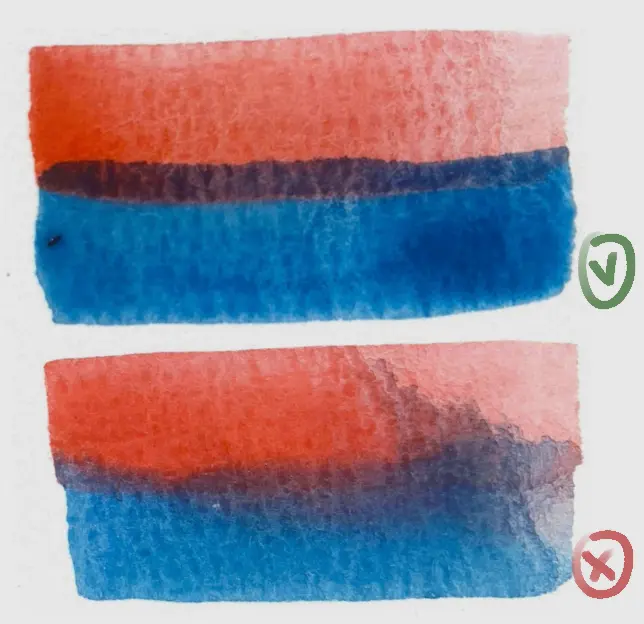
Have you always wanted to start watercolour painting but didn't know where to begin? In this article, I will take you back to the basics. We will look at the essential equipment and techniques you need to know to get started. We will also cover some common mistakes and how to avoid them. After that, you can start watercolour painting with your eyes closed!
MATERIALS FOR WATERCOLOUR
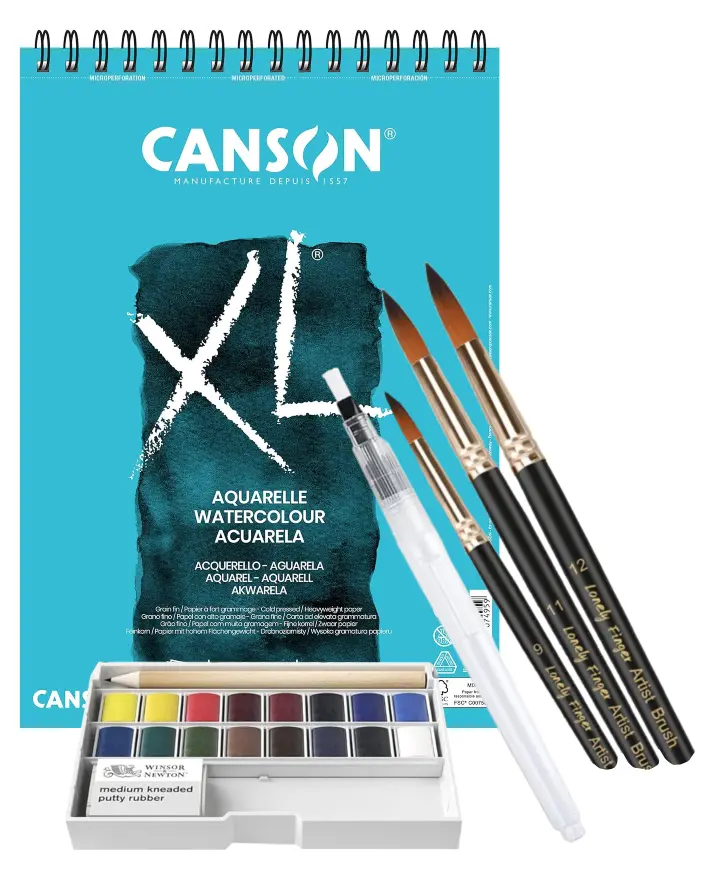
To start with watercolour, you don't need to spend a fortune on equipment, but it is important to choose the right tools. I recommend opting for a medium-sized soft brush, made from natural or synthetic fibers; you can choose one with or without a water reservoir. To make sure you're not mistaken, I recommend going for this set of watercolour brushes.
Watercolours are available in pans or tubes: pans are convenient for beginners, while tubes offer more intense colours. Here is a watercolour reference for beginners.
For the paper, choose a thick paper (at least 250g/m²) to prevent it from warping under water. I recommend this watercolour paper. Don't forget a palette to mix the colours and a pot of water to clean your brushes. With these items, you are ready to start!
BASIC TECHNIQUES TO GET STARTED WITH WATERCOLOUR
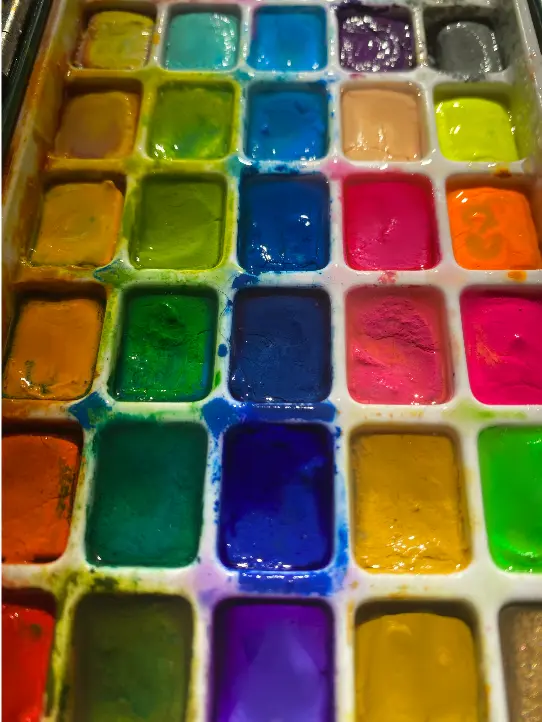
ACTIVATE YOUR WATERCOLOUR
Before you start painting with watercolours, it is very important to activate the colours! Watercolours are dry and in order to release all their pigmentation, it is necessary to awaken them with a little water. To do this, it is simple: take a clean brush, dip it in water and drop a few drops on each colour you want to use.
You can also choose to use a water sprayer. Wait a minute for the paint to rehydrate and voila, your colours are ready; you will see that the difference is very noticeable.
DILUTIONS
Dilution is the ratio between water and paint. The more water you add, the lighter and more transparent the color becomes. It's a bit like playing with the pigment intensity. For a bright and light effect, add a lot of water. For an intense shade, use less water.
What makes watercolour unique is precisely its ability to vary from delicate transparency to vibrant intensity. With a single colour, you can create a complete palette and thus, for example, play with transparent flat tints and more intense details.

WET ON DRY
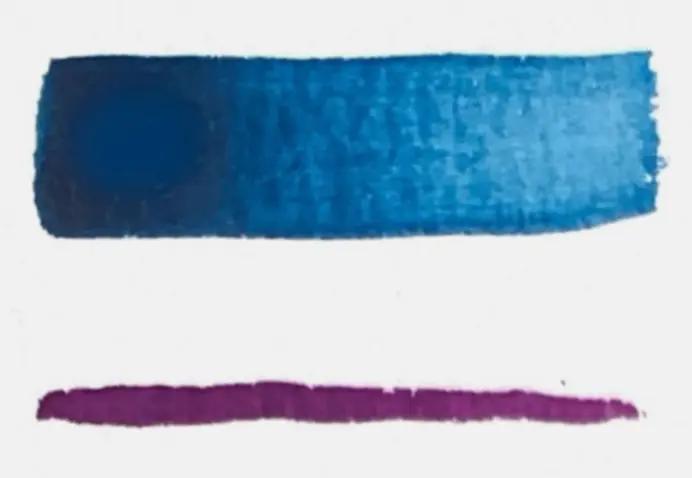
The wet on dry technique involves applying wet paint to a dry sheet. This results in sharp, precise edges, perfect for details or outlines. Be sure to control your brush well as there is very little room for error. This method is ideal for keeping a drawing clear and precise or for adding details once the previous layers are dry.
WET ON WET
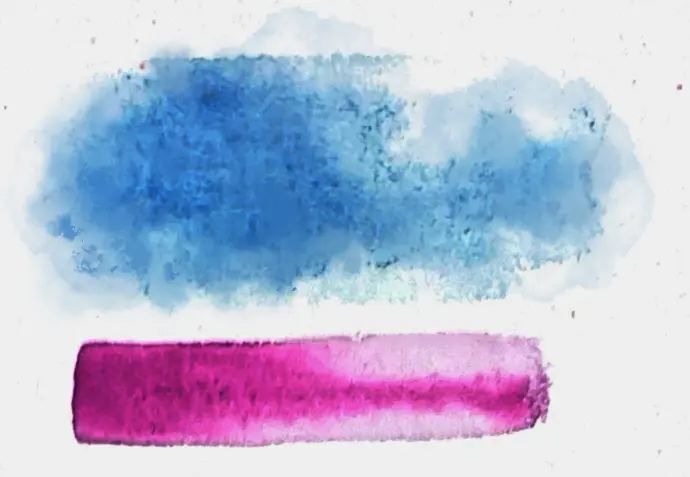
The wet-on-wet technique is the most widely used in watercolour painting and consists of applying wet colour to an already wet surface (e.g. by previously applying a brush loaded with water or to a freshly applied colour). This creates soft effects and natural shades, in which colours mix freely and randomly. It is a perfect technique for skies or organic renderings.
THE GLACIERING
A glaze is a very thin, transparent layer of paint applied over an already dry surface. Unlike a thick layer of paint, a glaze does not mask the underlying colours, but subtly alters them. This makes it possible to create additional depth, light or shading effects without losing the richness of the initial colours.
In watercolour, glazing is interesting because the transparency allows the colours to be layered while preserving the brightness of the paper. This makes it possible to adjust nuances or create subtle gradients without blocking the light, maintaining the light and fluid effect of watercolour.

THE GRADIENTS TO LEARN TO MASTER WATERCOLOUR
Gradients are essential for learning to master watercolour. There are many ways to create them, but here is my favorite technique.
1 - Choose your first colour and apply it from left to right;
2 - Choose your second colour and apply it in the opposite direction.
Working wet on dry, one should obtain fairly clean and precise shades; wet on wet, on the other hand, the colours will mix randomly and a much more organic result will be obtained.
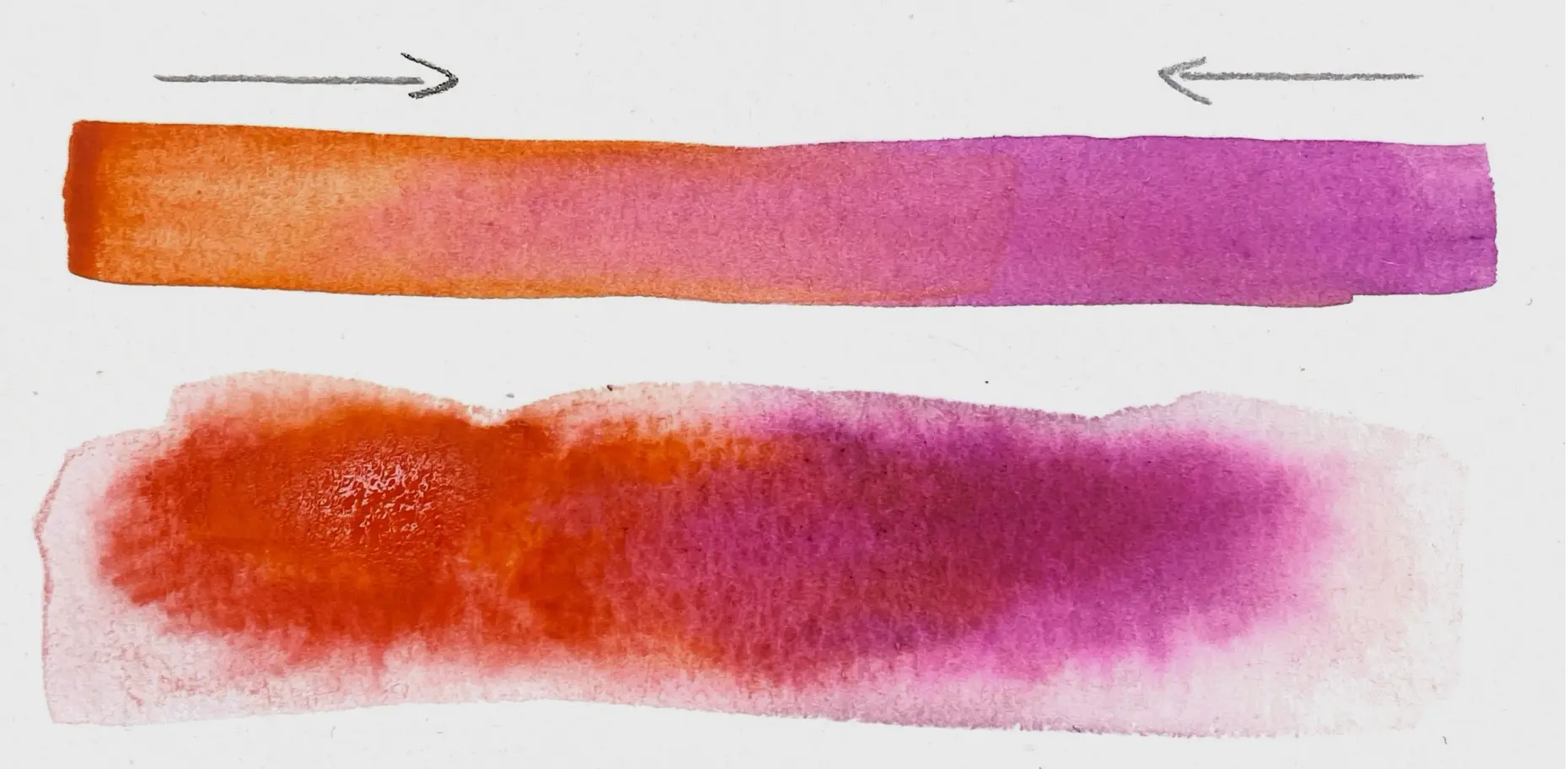
CORRECT YOUR MISTAKES
Correcting mistakes is not always 100% possible with watercolour, and this is actually one of the interesting aspects of this technique, which requires a certain level of letting go. However, there is a little trick to mitigate a mistake. If the paint is still wet, gently place a piece of paper towel or a clean sponge on it. This will absorb the excess water or pigment. If the paint is already dry, moisten the area with a clean brush, then dab.
It is possible that some pigments have already stuck to the paper, but that's ok: randomness is part of watercolour, and in time you will learn to tame these surprises, some of which may even become “happy accidents” as they lead you to develop your creativity.
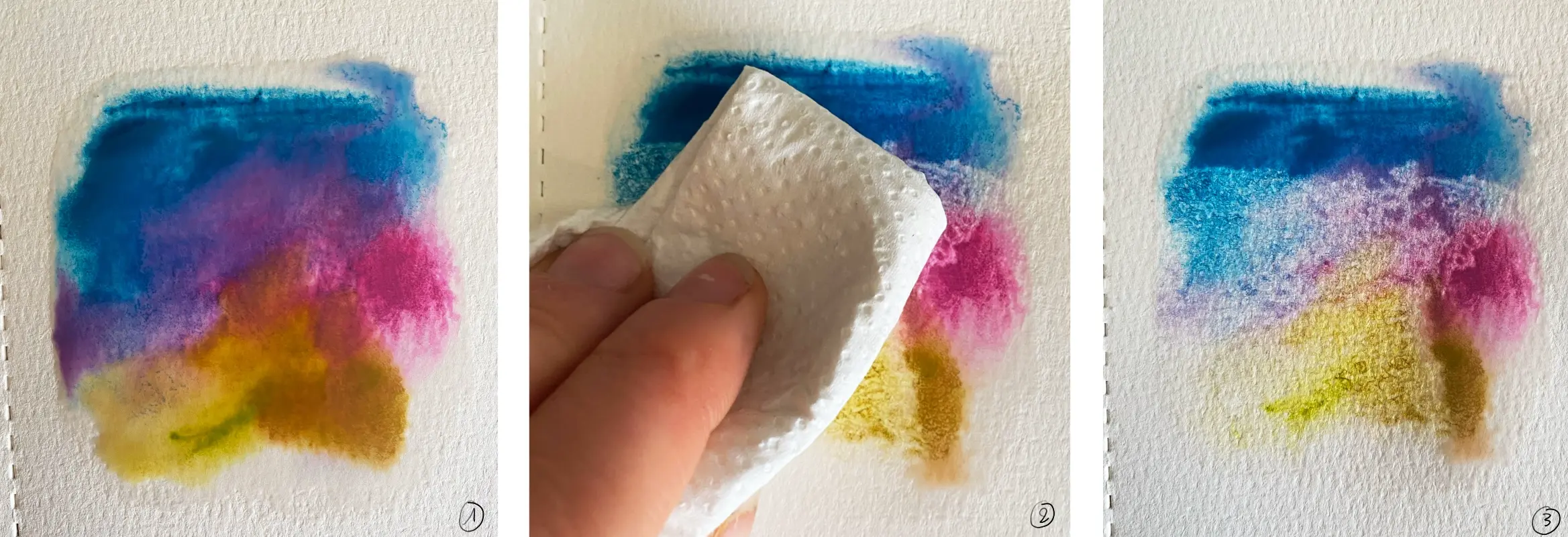
THE 3 COMMON MISTAKES WHEN STARTING WATERCOLOR
USING BAD PAPER
As we saw in the section on materials, good paper is essential! Yes, it has a cost, although there are options for all budgets, but don’t be tempted to use paper that is too thin (and especially not printer paper), as it may buckle under water, get damaged, or fail to withstand several layers of paint. The result will be dull and might even turn you off from watercolour, because you won’t be able to perform the techniques specific to this type of painting.
It is like being asked to make a cake without a mould: you can do it, but the result will be better and easier with a good mould.
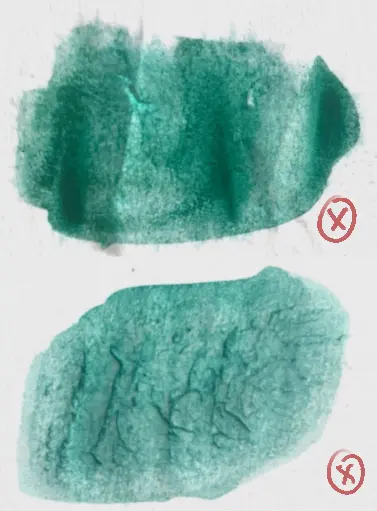
TOO MUCH WATER IN WATERCOLOUR
We have seen that watercolour is a wet paint that allows you to play with dilution. However, care must be taken not to dilute watercolour too much. It is common for some people to be disappointed with the quality of their work, finding it too opaque, when in fact they have simply diluted the pigments too much.
You can certainly dilute it if you want to work with glaze layers, but if you want to create a more precise drawing (like this one on the side), you must make sure to maintain a sufficient concentration of pigments.
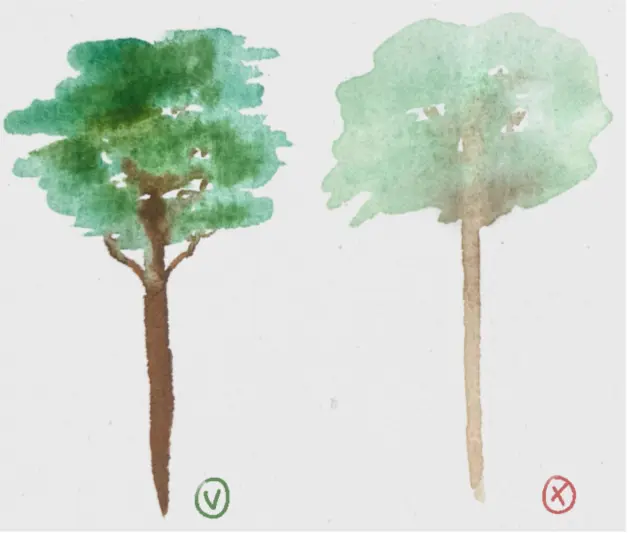
LACK OF PATIENCE
Watercolour can be unsettling because it takes time: the pigments mix slowly, the water takes time to dry, and when working with layers of washes, you must wait between each layer. A classic mistake is therefore to want to go too fast, especially when you want to paint two close areas, with different colours, without them mixing.
Take your time, let each layer dry, and work on spaced areas of the same drawing to avoid unintentional mixing. That's watercolor for you: patience.

And that's it, you have reached the end of this article! Now that you know the basics of how to start painting with watercolour, all that remains is for you to practice. Take your time, get to know your materials and their specific qualities, practise the basic techniques and, above all, have fun! 😊
Writer and Illustrator: Chloé Pouteau


Very interesting, I love working with watercolors 😁